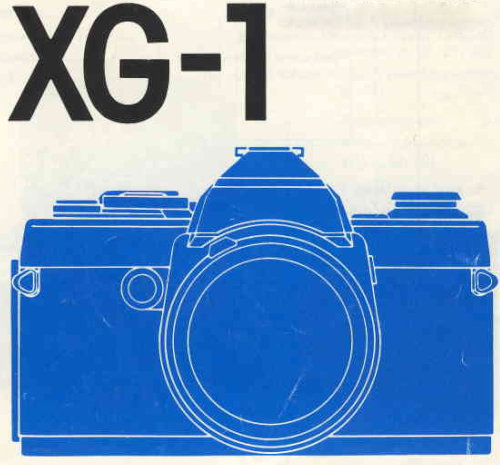
A List of the Best Minolta XG-1 Lenses for Every Budget
- Nathaniel Stephan
- Minolta x g1
- April 29, 2023
Table of Contents
The Minolta camera lenses for the Minolta XG-1 are truly exceptional in terms of their optical performance and build quality. These lenses are known for their sharpness, color accuracy, and beautiful bokeh, allowing photographers to capture stunning images with a unique character that is difficult to replicate with modern lenses.
The solid construction and precise mechanical engineering of these lenses has for the most part ensured a long lifespan and consistent performance. Despite the age of the lenses, it is still possible to find lenses in good usable condition. Avoid lenses with haze, fungus, or other defects.
Choosing the correct focal length for specific types of photography is crucial, as it can significantly impact the overall look and feel of your images. Wide-angle lenses, for instance, are perfect for capturing sweeping landscapes and architectural scenes, as they provide an expansive field of view that can encompass vast vistas.
On the other hand, telephoto lenses are ideal for wildlife and sports photography, as they allow you to get up close and personal with your subjects while maintaining a safe distance. They are also usefull for isolating your subject from the background, which is why they are the goto choice for portrait photography.
Standard or normal lenses, typically around the 50mm focal length, are versatile and suitable for a wide range of photography styles, from street to portrait. The 50mm f/1.8 and 50mm f/1.4 were both optional “kit lenses” that were offered at a discount with the XG-1.
By selecting the appropriate Minolta SR mount lens for your Minolta XG-1, you can ensure that your creative vision is fully realized, while also enjoying the timeless appeal of these exceptional vintage lenses.
Affiliate Advertising Disclosure
Outside the Shot is a participant in the Amazon Services LLC Associates Program, an affiliate advertising program designed to provide a means for sites to earn advertising fees by advertising and linking to Amazon.com.
As an eBay Partner, I may be compensated if you make a purchase. I also participate in affiliate advertising programs with KEH and Adorama. More can be found on the Affiliate Disclosure page.
Here is the list of the best lenses for the Minolta XG1:
- Prime Lens - MC Rokkor 58mm f/1.4
- Wide Angle Lens - Minolta 24mm f/2.8 MD W.Rokkor-X
- Portrait Lens - Minolta 135mm f/2.8 MD Tele Rokkor
- Zoom Lens - Vivitar Series 1 70-210mm f/3.5
- Macro Lens - Vivitar 90mm f/2.8 Macro
The best Minolta lenses are categorized by price and type of photography. Emphasis has been put on models that have large apertures so you are not locked into needing a fast film speed.
Any Minolta SR, MC, or MD lens will be compatible with the Minolta XG-1.
What Lens Mount Does the Minolta XG-1 Use?
The Minolta XG-1 uses the Minolta MD lens mount.
Technically it is the Minolta SR mount, but no one calls it that. It is called the MD mount because that was the name of the last revision to the Minolta mount.
Lenses are backward compatible with older camera models, so there isn’t a downside to referring to it as the MD mount instead of SR. Many other cameras use the same lenses, such as the Minolta X-700.
Lens Requirements for the Minolta XG-1: Unlocking the Full Potential
The Minolta XG-1 offers a versatile range of shooting modes, making it a darling among both beginners and seasoned photographers. However, to truly unlock the camera’s potential, you need the right lenses.
The Minolta XG-1 employs the Minolta SR lens mount, known for its wide variety of high-quality lenses. MD mount lenses are needed for advanced exposure modes. Make sure to get the right type of lens to take advantage of the camera’s shooting modes, such as manual mode, aperture priority, and exposure compensation?
Manual Mode
In the Manual mode, the photographer is granted complete control over both aperture and shutter speed settings. Any lens that fits the Minolta SR mount, from the late 1970s forwards, can be used for manual exposure. This includes all Minolta MC, MD, and third-party SR-mount lenses.
The key to using Manual mode effectively is to understand the aperture and shutter speed controls on your lens. The aperture ring, typically located towards the end of the lens, allows you to adjust the aperture (f-stop). The camera’s shutter speed dial lets you manage the shutter speed. Balance these settings to achieve your desired exposure.
Aperture Priority Mode
Aperture Priority mode is where the compatibility of your lens starts to play a more substantial role. In this mode, you select the desired aperture, and the camera automatically determines the appropriate shutter speed for a correct exposure. This means you do not need to use the shutter dial.
To fully utilize this mode, an MD series lens is required. These lenses have a smallest aperture lock which allows the camera to control the lens aperture. Simply set the aperture ring to the smallest aperture (the largest f-number), usually denoted in orange or green, and rotate it until it locks. (The maximum aperture is the smallest f-number on the lens.)
You can then adjust the aperture using the camera’s control dial, and the camera will automatically set the shutter speed.
MC and third-party SR-mount lenses without this feature can still be used in Aperture Priority mode, but they require the aperture to be set manually on the lens. The camera will then choose the shutter speed based on your manual aperture selection.
Exposure Compensation
Exposure Compensation is a feature that allows the photographer to adjust the camera’s metered exposure, intentionally making images darker or lighter as desired. This function can be used regardless of the lens attached.
On the Minolta XG-1, exposure compensation is achieved using the dedicated dial on the left side of the camera’s top panel. You can adjust exposure from +2 to -2 stops in full stop increments.
Whether you’re using an MC lens without the smallest aperture lock or a later MD lens with full functionality, exposure compensation is always at your disposal to fine-tune your exposure settings.
In summary, while any Minolta SR-mount lens will allow you to take great photos with the Minolta XG-1, selecting the right lens can enhance the versatility of this camera and make your photographic journey even more enjoyable. Understanding how different lenses interact with the camera’s shooting modes allows you to express your creativity fully and capture your unique vision.
Minolta SR vs MC vs MD
The Minolta SR mount is a bayonet style mount. The MC and MD revisions were made so that camera features could be added.
- SR - Features an automatic aperture diaphragm. When the camera shutter release is pressed, the camera will automatically stop down to the set aperture. This allows for focusing with the aperture wide open, so the focus screen is as bright as possible.
- MC - Adds meter coupling. This allows the camera to do full aperture metering. Previously you would have had to use stop-down metering, which required the lens to be stopped down to get a correct light meter reading.
- MD - Allows the camera to read the smallest aperture available and lets the camera set the aperture. The benefit of this is that combined with accurate metering it enables the use of shutter priority mode.
Standard Lens Cap Size
The standard lens cap and filter ring thread diameter used on most vintage manual focus Minolta lenses is 55mm.
There are lenses with smaller filter threads that were designed to be small and portable. Those models use 49mm filter threads.
Standard Camera Lenses
Here is a selection of 58mm, 50mm, and 45mm focal lengths that made up the selection of standard lenses for the XG1. Back when the camera was sold as new, there would have been a discount to buy a 58mm or 50mm lens with the camera as a kit. After all, what use is a camera without a lens?
Minolta 58mm f/1.4 MC Rokkor
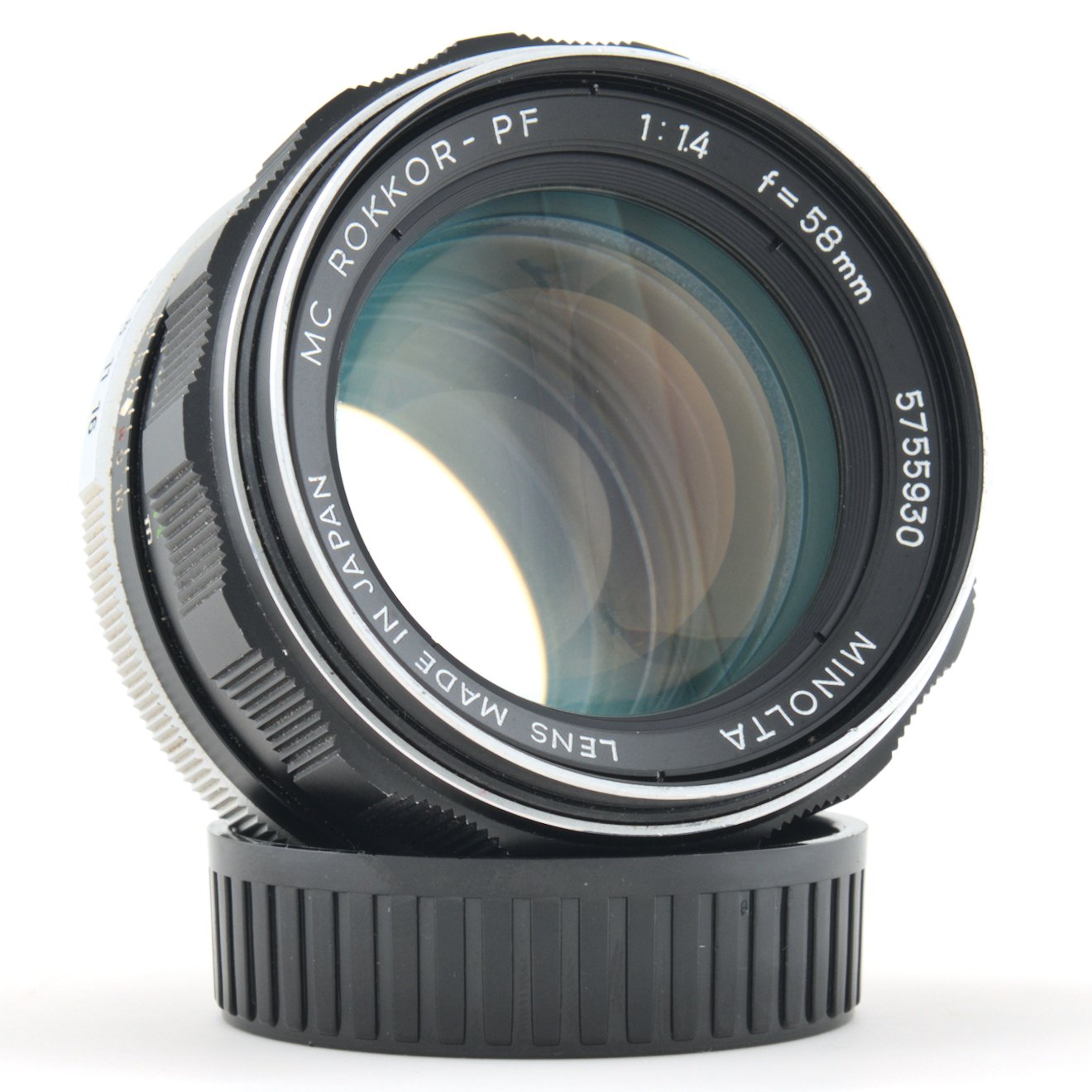
- “Kit” lens for the XG1.
- Excellent value.
- A novel focal length.
- 55mm filter threads.
See current price and more information on:
If you don’t already own it, a good first lens to get for the Minolta XG-1 is the Minolta 58mm f/1.4 MC Rokkor. The 58mm focal length is uncommon, which provides a fun and unique experience.
Adapted to an APS-C sensor digital camera, the field of view would be the equivalent of ~85mm on a full frame camera. That is perfect for portraits. Of course you could also adapt it to a full frame or micro four thirds camera.
Be careful when selecting your film speed if you intend to shoot wide open outdoors during the day. The maximum shutter speed of 1/1000 of a second on the camera might not be fast enough if you use ISO 400 film.
Like many lenses for the SR T series of cameras, there can be problems such as fungus, haze, or tight focus ring.
Minolta 50mm f/1.4 MD Rokkor-X
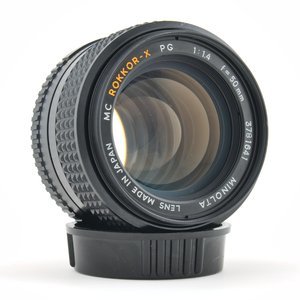
- Exceptional optics.
- Optical multi-coatings to improve performance.
- Easy to meter with at night.
- Comparatively inexpensive.
- 55mm filter threads.
See current price and more information on:
This is an excellent fast and sharp 50mm lens for the Minolta XG1. There is also an earlier MC version of the lens, but the MD version is easier to find.
The lens is one of the cheapest manual focus 50mm f/1.4 lenses available from any of the manufacturers that made film cameras. If you want an even cheaper option, look for the Minolta 50mm f/1.7.
Minolta 45mm f/2 MD Rokkor-X
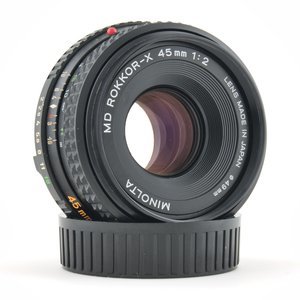
- Great image quality.
- Small, compact, and light.
- Easy to find.
- Inexpensive.
- 49mm filter threads.
See current price and more information on:
This is another model with uncommon focal length lens from Minolta. It’s a popular choice if you are looking for a small and light pancake lens for your XG-1.
They are very cheap and can easily be found in good condition. There is an earlier MC version that is also a good option.
Wide Angles
Minolta 24mm f/2.8 MD
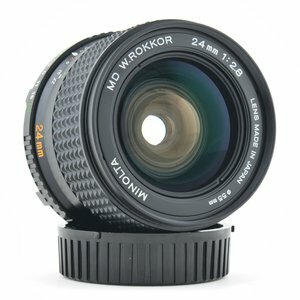
- Great combination with a 50mm lens.
- Optical coatings help improve sharpness and reduce glare.
- Excellent wide angle lens.
- 55mm filter threads.
See current price and more information on:
Other versions of this lens are marked as W.Rokkor or Rokkor-X. All three are excellent choices for a wide-angle lens.
While Minolta made wider lenses, they are either expensive and/or suffer from significantly more distortion than a modern wide-angle lens.
If you want something special, the Minolta MD VFC Rokkor 24mm f/2.8 has a completely different design than other 24mm lenses. VFC stands for ‘variable field curvature’.
Using the VFC control ring enables the plane of focus to be adjusted from flat to convex or concave. It is a very rare feature to find on a lens, which makes them expensive.
Minolta 28mm f/2.8 MD W.Rokkor-X
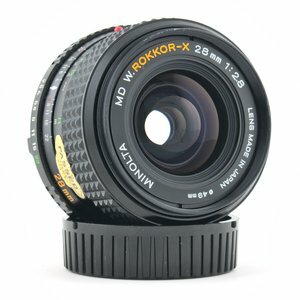
- Works well with a standard lens.
- Small and compact.
- Very easy to find.
- Inexpensive.
- 49mm filter threads.
See current price and more information on:
Avoid the ‘Celtic’ model of this lens as it was introduced to be a budget line of lenses. All of the other versions that feature Rokkor in the name have a better build quality.
It is the widest angle lens available that remains easily affordable. Anything wider will cost multiple times what this lens should be available for.
Another possible alternative is the W Rokkor HG 35mm f/2.8.
Portrait & Telephoto
Minolta 135mm f/2.8 MD
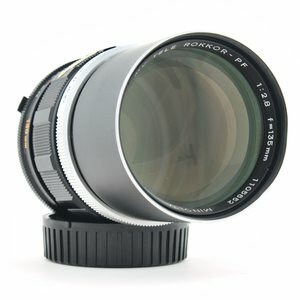
- 85mm substitute.
- Excellent value.
- Relatively inexpensive.
- Widely available.
- 55mm filter threads.
See current price and more information on:
Minolta made several versions of this telephoto lens, most likely due to its popularity. When the Minolta XG-1 was released, 135mm lenses were more popular for portrait photography than other telephoto lenses.
A big part of that was that a 135mm was close to half the price of an 85mm. Today on the used market, 135mm lenses can be had for a fraction of what 85mm lenses sell for.
Minolta 85mm f/1.7 MC Rokkor
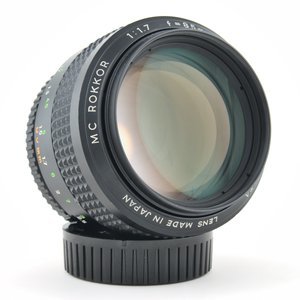
- Sharp stopped down.
- Fairly expensive.
- Can be difficult to find in good condition.
- 55mm filter threads.
See current price and more information on:
There is also a second MD version of the Minolta Rokkor 85mm lens. The difficulty with either version of this telephoto lens will be finding one in good condition.
Make sure to carefully read product descriptions. Many will be listed as in “excellent” condition while having fungus and/or haze.
If you want a copy of this lens, you’re likely going to have to buy one off of eBay from Japan. KEH, Adorama, or Amazon rarely have copies of the lens for sale.
Zooms
Before the introduction of autofocus, in the early 1980s, there were a small number of lenses made by third-party manufacturers that performed better than what Minolta was offering.
A large number of these top-performing lenses were released with Vivitar branding. Any zoom lens that has the Vivitar Series 1 branding on it is going to have the best optics you’ll see from a vintage zoom lens.
Unfortunately, finding copies of these lenses in good condition can be extremely difficult. Beyond that, no vintage zooms offer outstanding performance. If you see one for sale that is cheap enough, it may be worth picking up, but I don’t think they are worth hunting for.
Vivitar Series 1 70-210mm f/3.5
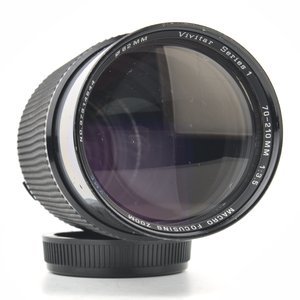
- Covers a popular zoom range.
- Great for portrait or wildlife photography.
- A rare time when a third-party lens is the better choice.
- 62mm filter threads.
See current price and more information on:
This is one of a handful of third party lenses that outperforms first party lenses. Image quality from this lens on the Minolta XG1 is going to be better than any Minolta counterpart. However, the fit and finish are a little lackluster and age makes that worse.
For sharp photos, just like every vintage zoom lens, you will have to stop the lens down to f/5.6 or f/8. There are no intermediate stops between f/3.5 and f/5.6.
Shooting at an f/5.6 aperture will cause many lighting situations to be difficult without the use of an external flash. You’ll be fine shooting outdoors during the day.
The lens is sold with mounts for other camera systems. If you decide to buy one, make sure that it is for the Minolta MD mount.
Vivitar Series 1 28-90mm f/2.8-3.5
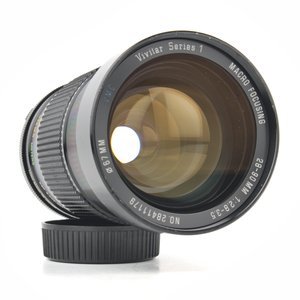
- Covers a useful zoom range.
- Great for everyday general photography.
- A rare time when a third-party lens is the better choice.
- 67mm filter threads.
See current price and more information on:
Depending on the type of photography you intend to do, this could be a more useful zoom range.
However, owning 58mm and 28mm primes will make a majority of the zoom range redundant. The primes also have better image quality, are smaller, and weigh less.
Minolta Macro Lenses
For capturing photos at macro magnification (1x), focal lengths in the 90mm-105mm range will be the best choice.
You’ll have a large enough working distance to be able to use flash, while avoiding excessive weight and high costs that come with longer focal lengths.
All of the Minolta MD macro lenses require the use of extension tubes to reach 1x magnification. These tubes were branded as ’life-size’ adapters, which can be difficult and expensive to purchase if they are not included with a lens.
Vivitar 90mm f/2.8 Macro
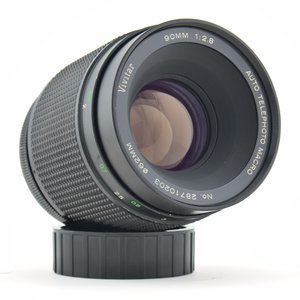
- Ideal focal length for 1x magnification.
- Widely available.
- Incredible value.
- 62mm filter threads.
See current price and more information on:
My favorite vintage macro, the 90mm Vivitar, was made with a variety of camera mounts. Fortunately, it is not difficult to find one for the Minolta XG-1 with a Minolta MD mount.
The lens is ideal for shooting macro at 1:1 magnification because you’ll get around 3 inches of working distance. Emulsions with a slow film speed will produce the sharpest image possible.
Shutter speeds will need to be slow without the use of a flash. Even with a flash, it can make sense to use the mirror lockup feature on the XG-1.
Both of the Vivitar macro models were made by Komine and were released under several different brand names such as Panagor, Elicar, Quantaray, Spiratone, and Rokunar.
There is a Vivitar 90mm Macro Review and a Vivitar 55mm Macro Review.
Vivitar 55mm f/2.8 Macro
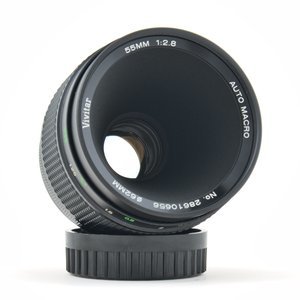
- The second best vintage macro lens I’ve used.
- An outstanding lens for close-up photography.
- Can achieve life-size magnification without needing an extension tube.
- 55mm filter threads.
See current price and more information on:
The Vivitar 55mm is an excellent choice for close-up photography with the Minolta XG-1. That includes copy work, nature, and tabletop photography.
At 1X magnification, there is a small amount of working distance. An upside to that is that at 0.5x magnification you won’t have to be several feet away from the subject.
To get the best results use a tripod and mirror lock up to prevent camera shake.
An earlier f/3 version of the lens exists and should be avoided. The f/2.8 version is significantly sharper.
Minolta 50mm f/3.5 MD Macro
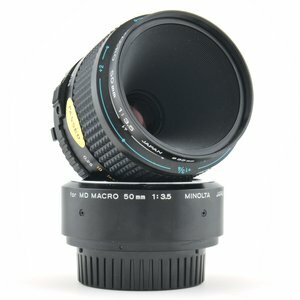
- The second best vintage macro lens I’ve used.
- An outstanding lens for close-up photography.
- Can achieve life-size magnification without needing an extension tube.
- 55mm filter threads.
Affiliate Links:
I own the worst two models of the lens, the MD non Rokkor and Celtic. Both were designed with lower costs than a Rokkor model.
In order to reach 1:1 magnification, a 25mm extension tube is needed called a ’life-size adapter’ by Minolta. Make sure one is included as they can be difficult to find.
It is well suited to studio use, where the camera can be on a sturdy tripod. To get the best sharpness from the lens lock the mirror up to prevent vibrations from the mirror slap.
Used Minolta Lenses
Prices change all the time depending on supply and interest. Expect prices to climb for the black body XG-1, and lenses targeted at professional photographers.
Keep in mind that the XG-1 is a forty year old camera. When things break, parts can be hard to find.
However, the Minolta MD has not seen as large of price increases as the Nikon F-mount, Pentax K-mount, or the Minolta A-mount, which has AF and benefited from the merger with Konica.
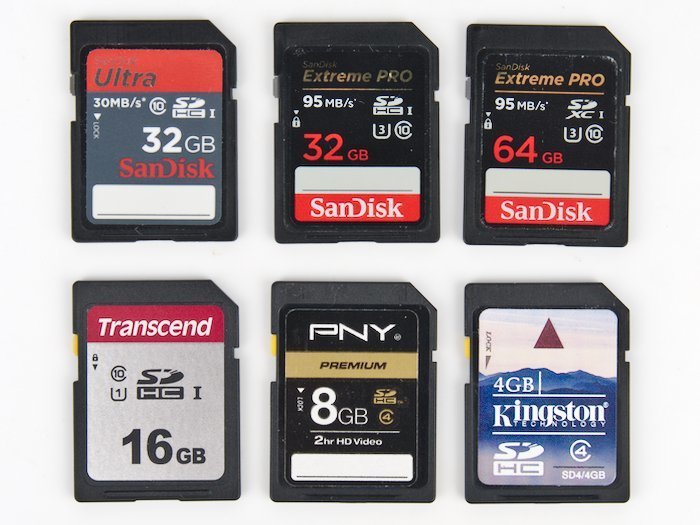
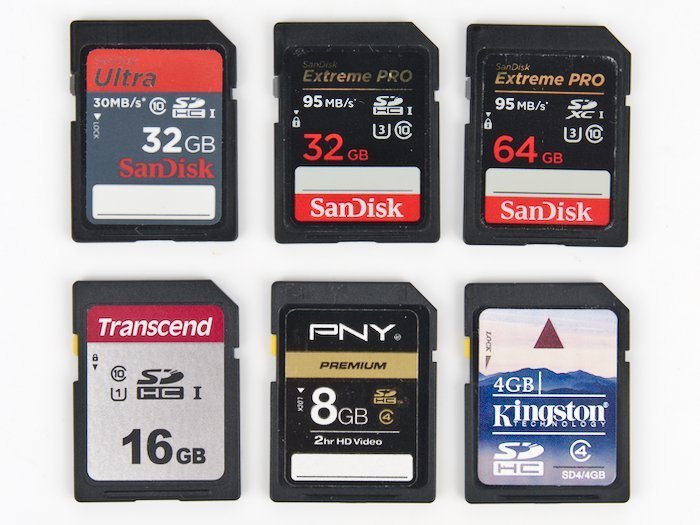
![Vivitar 55mm f/2.8 Macro Lens Review [Komine]](https://www.outsidetheshot.com/lens-reviews/Vivitar-55mm-f28-Macro-Lens.jpg)